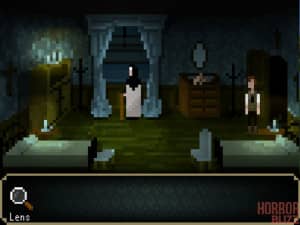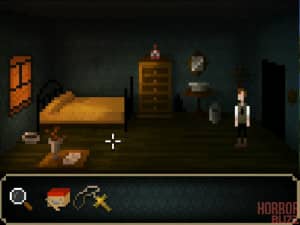 A great site called Gameshed.com is currently offering a chance to play the first four episodes of The Last Door (Developed by The Game Kitchen). They are actually a very good site for all kinds of scary games. For the purposes of this review they offered us a chance to play the entire first season of The Last Door in exchange for mention of the preview they are running. We are very happy to report that the game is a creative, refreshing change of pace for the “retro” game genre. Below is our review.
A great site called Gameshed.com is currently offering a chance to play the first four episodes of The Last Door (Developed by The Game Kitchen). They are actually a very good site for all kinds of scary games. For the purposes of this review they offered us a chance to play the entire first season of The Last Door in exchange for mention of the preview they are running. We are very happy to report that the game is a creative, refreshing change of pace for the “retro” game genre. Below is our review.
“The Last Door” has a story which borrows heavily from gothic horror and weird fiction. It wears its love of writers like Poe, Lovecraft and Machen on its sleeve. The player takes the role of a young man in Victorian England who is trying to understand what caused his friend to commit suicide. The game itself is divided into four separate episodes, each one essentially a chapter of the search. A nice cross section of Victorian society is presented, with the player visiting upper-class manors, back alleys of slums, and even a bit of the faddish divination of the time. Most impressively though, the game is not content to rely on its literary influences as a crutch; instead of being like any number of other Lovecraft-inspired games which simply rely on the notions of madness and inevitably Cthulhu, “The Last Door” builds its own mythology with an eye toward what made those of older writers (like Lovecraft and Machen) work so well and become so memorable.
 Some players may find the game’s visual aesthetic a bit tiresome. Like many other indie games before it, “The Last Door” uses 8-bit sprites to try to create a retro feel. While this doesn’t necessarily detract from the game, it certainly doesn’t bring anything special or new to the table. Characters are essentially only discernible from one another by their hair color, which can make some of the flashback scenes that use altered color palettes a little confusing. I understand that for an independent developer, sprite work is going to be much easier than creating 3D models, but the end result here is generic at best. The game deserves a better art style than this.
Some players may find the game’s visual aesthetic a bit tiresome. Like many other indie games before it, “The Last Door” uses 8-bit sprites to try to create a retro feel. While this doesn’t necessarily detract from the game, it certainly doesn’t bring anything special or new to the table. Characters are essentially only discernible from one another by their hair color, which can make some of the flashback scenes that use altered color palettes a little confusing. I understand that for an independent developer, sprite work is going to be much easier than creating 3D models, but the end result here is generic at best. The game deserves a better art style than this.
Thankfully, the sound design does not match the visual design. There are mercifully no beeps or chiptunes to be found here. Instead, the music of “The Last Door” fits in very well with the game’s strong narrative. It’s a dark, ominous sort of affair with pounding percussion and swelling strings. The sound effects are generally simple but that’s all that the game really requires. Frankly as long as the game sounded better than it looked, that was enough for me and the game rises above and beyond that simple requirement. There are a lot of moments where the music really sells the tension and creepiness that the visual elements of the game fail to create.
 The gameplay of “The Last Door” will probably be familiar to many players. It’s an old school adventure game. You find items and use them to solve simple puzzles in one area to help you go to the next area and solve those puzzles there. There are a few of these puzzles that fall a bit short but for the most part they’re strong and they make sense, and that’s far more than you get from most games emulating retro adventure game puzzles. The cursor changes when you move it over an object that you can interact with, which is a nice addition to this sort of gameplay. The game also allows you to toggle between its default faux-vintage font and a more modern dyslexia-friendly font. This is a wonderful little touch that helps make the game more accessible. In short, the gameplay is nothing new but it’s very successful in accomplishing what it sets out to do.
The gameplay of “The Last Door” will probably be familiar to many players. It’s an old school adventure game. You find items and use them to solve simple puzzles in one area to help you go to the next area and solve those puzzles there. There are a few of these puzzles that fall a bit short but for the most part they’re strong and they make sense, and that’s far more than you get from most games emulating retro adventure game puzzles. The cursor changes when you move it over an object that you can interact with, which is a nice addition to this sort of gameplay. The game also allows you to toggle between its default faux-vintage font and a more modern dyslexia-friendly font. This is a wonderful little touch that helps make the game more accessible. In short, the gameplay is nothing new but it’s very successful in accomplishing what it sets out to do.
There are a lot of options in the fields of retro games and Lovecraft-inspired games. Most of them really are not very good. “The Last Door” is. It’s more than a nice surprise, it’s a breath of fresh air, showing us that some game designers actually understand not just what made those stories tick, but that they’re capable of taking that knowledge and crafting something great out of it. The art style may leave a bit to be desired, but “The Last Door” is more than worth looking past that problem.
As we mentioned, the good folks at GameShed.com provided us with a free copy of the STEAM version of The Last Door: Season One game for the review purposes. The game can be purchased from STEAM or from the official website. If you just want to give the game a try, but you can check out the first 4 episodes of the game for free at GameShed as well as other great horror games. The first episode can be found here.







